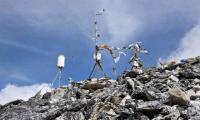WASHINGTON: US consumer prices unexpectedly rose in November as a decline in the cost of gasoline was offset by increases in rents, offering more evidence that the Federal Reserve was unlikely to pivot to interest rate cuts early next year.
The report from the Labor Department on Tuesday also showed prices for used cars and trucks rebounded last month after five straight monthly decreases, helping to boost underlying inflation. Americans also paid more for healthcare and motor vehicle insurance.
The slightly firmer inflation readings followed in the wake of data last Friday showing job gains accelerated in November and the unemployment rate fell to 3.7 percent from nearly a two-year high of 3.9 percent in October. Officials from the U.S. central bank were due to gather for a two-day policy meeting on Tuesday.
"Ongoing housing price pressures and their outsized influence on inflation overall tell a large part of the story of why calls for early and rapid Fed monetary policy easing should be viewed with significant scrutiny," said Kurt Rankin, senior economist at PNC Financial in Pittsburgh, Pennsylvania.
"The Fed will not cut rates until inflation's drivers are well and truly tamed." The consumer price index (CPI) edged up 0.1 percent last month after being unchanged in October, the Labor Department's Bureau of Labor Statistics said. Gasoline prices decreased 6.0 percent after dropping 5.0 percent in the prior month. But natural gas cost more as did electricity.
Food prices rose 0.2 percent after gaining 0.3 percent in October. Grocery food prices ticked up 0.1 percent amid rises in the costs of cereals and bakery products as well as fruits and vegetables. Meat, fish and eggs, however, cost less.
In the 12 months through November, the CPI increased 3.1 percent after rising 3.2 percent in October. The annual increase in consumer prices has slowed from a peak of 9.1 percent in June 2022. Inflation remains above the Fed's 2 percent target.
Janet Yellen, US Treasury secretary, said Tuesday’s figures confirmed that inflation was coming down “meaningfully”, while President Joe Biden emphasised that, despite the fall in the consumer price index, unemployment remained below 4 percent. “Workers’ wages and household wealth are higher now than they were before the pandemic, adjusted for inflation”, he said.
Following the data, financial markets continued to push back expectations of a rate cut to May from March, according to CME Group's FedWatch Tool, a process that was set in motion following last Friday's upbeat news on the labor market.
“The Fed keeps telling us they don’t have confidence that they can say with certainty that inflation is going to [its target of] 2 per cent anytime soon,” said Omair Sharif, president of forecasting group Inflation Insights. “I don’t think that confidence can be there after today’s numbers.”
He added that the figures did not signal “an all clear”. Analysts took the core inflation data as a sign that the path to bringing the figure down next year will be a bumpy one. While the market still anticipates a quarter-point cut in interest rates by next May, traders trimmed their expectations after the data release.
The Fed is expected to leave rates unchanged on Wednesday, with economists confident that its policy tightening campaign is over. The central bank has raised its policy rate by 525 basis points to the current 5.25 percent-5.50 percent range since March 2022.
U.S. stocks were slightly lower in early trading. The dollar fell against a basket of currencies. U.S. Treasury prices were mixed. Excluding the volatile food and energy components, the CPI increased 0.3 percent in November after climbing 0.2 percent in the prior month. The so-called core CPI was lifted by rents, which increased 0.5 percent. Owners' equivalent rent, a measure of the amount homeowners would pay to rent or would earn from renting their property, also rose 0.5 percent after increasing 0.4 percent in October.
Rental inflation could, however, moderate considerably next year as the rental vacancy rate increased to more than a two-year high in the third quarter, and there is a large stock of apartment buildings in the pipeline.
Underlying inflation was also lifted by a 1.6 percent surge in prices of used cars and trucks, which is likely temporary. Wholesale prices for used motor vehicles briefly rose amid worries about the impact of the 1-1/2-month United Auto Workers strike that began in September and ended in late October.
Healthcare costs accelerated 0.6 percent after climbing 0.3 percent in October, boosted by increases in the cost of physicians' services and prescription medication. Consumers, however, got relief from cheaper apparel, with prices declining 1.3 percent. Prices for household furnishings and operations fell as did the cost of communication, recreation, airline fares and new motor vehicles.
The core CPI increased 4.0 percent on a year-on-year basis in November after advancing by the same margin in October. Shelter costs, which surged 6.5 percent, accounted for nearly 70 percent of the year-on-year rise in the core CPI.
Carlyle boss Harvey Schwartz. — Bloomberg FileThe world from the perspective of the US-focused investor looks pretty...
A currency dealer counts US dollars at a shop in Karachi. — AFP/FileLAHORE: Remittances in Pakistan are not in line...
A session is going to start in the Milken Institute conference in the Los Angeles. — YouTube/CGTN...
An investor looking at the benchmark KSE-100 in this undated picture. — AFP/FileKARACHI: Pakistan's stocks are...
A saleswoman stands next to gold necklaces at a jewellery store in Bangalore. — AFPNew Delhi: Demand for physical...
Farmers load a donkey-drawn cart with produce as Egyptian army soldiers stand on guard near Egypt's Suez Canal...







